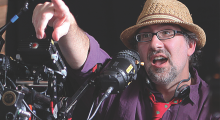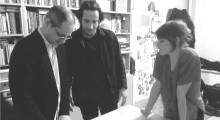Line Items
-
There’s a Critic On Set!

In the nearly ten years I have worked as a film critic and journalist, the sources and stability of my income have severely varied. Freelance movie reviewing for multimedia outlets, like The Rotten Tomatoes Show on the now-defunct Current TV, or Medium Rare TV in San Francisco, kept me afloat through film school. Then in Sydney, Australia, internships in advertising and radio paid well enough for me to start and support a boutique film blog, CineMalin: Film Commentary and Criticism. But in Austin, Texas, where I moved for graduate school some years ago, employment options for professional film writers are […]
-
The Fine Print: How To Understand and Negotiate a Film Distribution Contract

There are many new distribution options for the independent producer. The old media includes theatrical, broadcast/cable, home video; new media’s alphabet soup includes TVOD, SVOD, AVOD, EST, PPV, streaming and nontraditional theatrical. As new distribution channels develop, new distribution companies emerge. But not all distributors are effective in all mediums and markets. Just as you would not expect Netflix or Vimeo to release your work theatrically (Netflix’s recent self-originated productions to the contrary), you would not expect Gathr and Tugg to broadcast or cablecast your work. As a consequence of all these new distribution channels and the splitting up of […]
-
Still the One: An Independent Film Guide to On-Set Still Photography

In an excerpt from his recently released and highly recommended book, The Cheerful Subversive’s Guide to Independent Filmmaking, filmmaker Dan Mirvish explains how to work with — or deputize — a film set photographer. The Cheerful Subversives Guide to Independent Filmmaking is now available from Amazon and other retailers. Back in the pre-digital days, still photographers used SLR cameras buried in giant, black, soundproof boxes, so that the shutter-mirror click didn’t interfere with sound takes. Usually they were shooting black-and-white stills and sometimes color slide film. The main reason you needed a separate still photographer was that many distributors and […]
-
Negative Aspects
Aspect ratios are a film’s canvas; the size of your frame determines the look of your film and is one of the essential questions that a filmmaking team faces in preproduction. Lawrence of Arabia wouldn’t be Lawrence of Arabia if it wasn’t for its incredible widescreen cinematography and sense of scale. Filmed with anamorphic lenses and screened in both 35mm and 70mm, the film was shot and projected at a 2.20:1 aspect ratio. Properly presented in movie houses, the widescreen image would be masked to remove the negative space around the image that we commonly call letterboxing. One would think […]
-
It’s Not Always About the Money

There’s been a great deal of talk recently in our film community about the concept of sustainability. There hasn’t, however, been a great deal of precision. Take the word itself — “sustainable.” It’s most often defined by its absence. But by the time we ask, “What is a sustainable career?” the answer comes back, and it’s usually simply: “Not this.” We’ve adopted the idea of sustainability from the environmental movement, where it describes the quest to make an ecosystem stable and long-lasting. Sustainability’s myriad definitions range from the utopian (“all systems in dynamic balance”) to the terse, harsh pragmatism of its Latin root, […]
-
The Big Transition: How to Break into TV Writing, Part One

Maybe you’ve had some success writing features. You’ve sold a spec, landed an assignment, made the Black List or wrote and directed your own indie feature. Maybe you’re a playwright, or you’ve got a web series, or you’ve made a few shorts, or even written a few good features. Or maybe you’re simply an emerging writer working toward that first sale or produced credit. No matter — in today’s film business, you can be any one of the above and still be thinking about one thing: moving into television. If you’re thinking about trying a TV staffing job, or even […]
-
How a DCP Gets Made

“I was once Inside Llewyn Davis. Now I am Mad Max: Fury Road.” I came up with that Instagram caption while working a festival in suburban New Jersey last spring. Toward the end of the festival, UPS made a delivery of a couple of battered Deluxe/Technicolor cases that had seen better days. The label on the box read Tina’s Heroes, which was the secret title that Warner Brothers shipped Mad Max to theaters as. I chuckled at the reference to the hit song from Beyond Thunderdome, and then I looked at all of the other labels. There was a large piece of […]
-
Weather Advisory: How Climate Change is Changing Location-Based Film Shooting

Throughout the history of cinema, from It’s a Wonderful Life and Doctor Zhivago to Fargo and The Ice Storm, filmmakers have relied on snow to create authentic settings and magical worlds. But in the age of climate change, capturing snow on film has become a serious challenge for filmmakers no longer able to count on the real thing, as was the case with last year’s The Hateful Eight and The Revenant. Of course, filmmakers like Quentin Tarantino and Alejandro Iñárritu have the financial resources to enable them to wait for snowfall, generate artificial snow, create CGI snow, or any combination […]
-
Digital Motion Picture Cameras in 2016: New Horizons

In this, my sixth annual camera round-up for Filmmaker, I’ll explore the latest developments and trends associated with cameras — as I have each year — which taken together continue to define new directions in digital cinema. I’ll highlight cameras that exemplify these trends. Those seeking an end-in-sight to a decade’s worth of profound change in camera technology might want to stop reading here. In my 2015 camera round-up, I touched on issues of design including modularity, new materials, a return to ergonomics; the birth of camera apps; wirelessness and the dawn of camera IP connectivity; the mirrorless revolution with […]
-
Act Naturally: Working with Caveh Zahedi on the Web Series, The Show about the Show

Caveh Zahedi played the same edit over and over, one too many times. “I think I’m gonna go, man,” I grumbled. I’d reached my breaking point. The idea of a rough cut that gets whittled down doesn’t work for Zahedi. He needs to sand, polish and lacquer each piece of wood before deciding if he even wants to use that wood. Basically, he fine-cuts each take. Why, I’ve asked countless times, can’t we just choose the best take and work it in? His answer: how can we tell what the best take is unless we see them all working at […]
